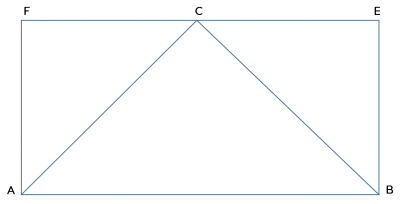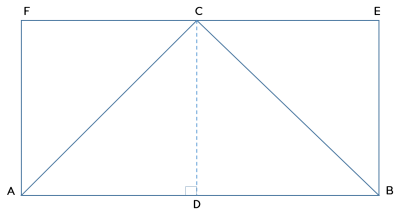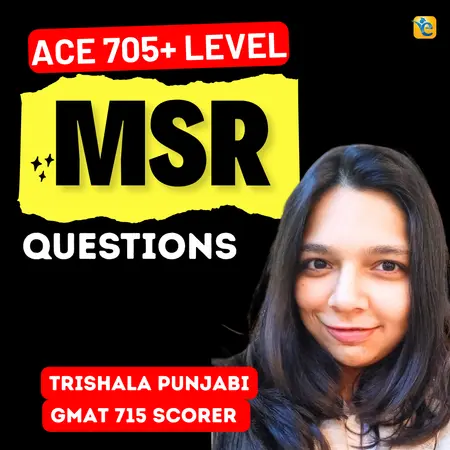Events & Promotions
|
|

GMAT Club Daily Prep
Thank you for using the timer - this advanced tool can estimate your performance and suggest more practice questions. We have subscribed you to Daily Prep Questions via email.
Customized
for You
Track
Your Progress
Practice
Pays
Not interested in getting valuable practice questions and articles delivered to your email? No problem, unsubscribe here.
- Nov 22
11:00 AM IST
-01:00 PM IST
Do RC/MSR passages scare you? e-GMAT is conducting a masterclass to help you learn – Learn effective reading strategies Tackle difficult RC & MSR with confidence Excel in timed test environment - Nov 23
11:00 AM IST
-01:00 PM IST
Attend this free GMAT Algebra Webinar and learn how to master the most challenging Inequalities and Absolute Value problems with ease. - Nov 25
10:00 AM EST
-11:00 AM EST
Prefer video-based learning? The Target Test Prep OnDemand course is a one-of-a-kind video masterclass featuring 400 hours of lecture-style teaching by Scott Woodbury-Stewart, founder of Target Test Prep and one of the most accomplished GMAT instructors.
Kudos
Bookmarks
C
Be sure to select an answer first to save it in the Error Log before revealing the correct answer (OA)!
Difficulty:
 95%
(hard)
95%
(hard)
Question Stats:
51% (02:43) correct 49%
(02:44)
wrong
49%
(02:44)
wrong  based on 375
sessions
based on 375
sessions
History
Date
Time
Result
Not Attempted Yet
Q. Triangle ABC is inscribed in a rectangle ABEF forming two right triangles: AFC and BEC. Is triangle ABC an equilateral triangle?
Answer Choices :
Thanks,
Saquib
Quant Expert
e-GMAT
Register for our Free Session on Number Properties (held every 3rd week) to solve exciting 700+ Level Questions in a classroom environment under the real-time guidance of our Experts

- (1) BE = (\(\sqrt{3}AB)/2\)
(2) Point C is the midpoint of EF
Answer Choices :
- A. Statement (1) ALONE is sufficient, but statement (2) alone is not sufficient to answer the question asked.
B. Statement (2) ALONE is sufficient, but statement (1) alone is not sufficient to answer the question asked.
C. BOTH statements (1) and (2) TOGETHER are sufficient to answer the question asked, but NEITHER statement ALONE is sufficient to answer the question asked.
D. EACH statement ALONE is sufficient to answer the question asked.
E. Statements (1) and (2) TOGETHER are NOT sufficient to answer the question asked, and additional data specific to the problem are needed.
Thanks,
Saquib
Quant Expert
e-GMAT
Register for our Free Session on Number Properties (held every 3rd week) to solve exciting 700+ Level Questions in a classroom environment under the real-time guidance of our Experts

Kudos
Bookmarks
Solution
Steps 1 & 2: Understand Question and Draw Inferences
Given:
The given information corresponds to the following figure:

To find: Is triangle ABC equilateral?
Step 3: Analyze Statement 1 independently
- • \(\mathrm{BE}=\frac{\sqrt3}2\mathrm{AB}\)
•
- Let’s drop a perpendicular CD on side AB.

- • CD is parallel to and equal to BE.
- o So, CD = \(\frac{\sqrt3}2\mathrm{AB}\)
- o Then \(\mathrm{AD}\;=\frac{\mathrm{AB}}2\)
o So, \(\tan(\angle\mathrm{CAD})=\frac{\mathrm{CD}}{\mathrm{AD}}\;=\;\frac{\frac{\sqrt3}2\mathrm{AB}}{\frac{\mathrm{AB}}2}=\;\sqrt3=\tan60^\circ\)
o Thus, \(\angle\mathrm{CAD}=60^\circ\)
• By Angle sum property therefore, \(\angle\mathrm{ACB}=60^\circ\)
• Thus, the triangle ABC is an equilateral triangle
• But the question is, is D the mid-point of AB?
• We do not know.
Therefore, Statement 1 is not sufficient to answer the question.
Step 4: Analyze Statement 2 independently
- • Point C is the midpoint of EF
• Let’s drop a perpendicular CD on side AB
- • CD is parallel to and equal to BE.
• Since C is the mid-point of EF, D will be the mid-point of AB.
- o Therefore, \(\mathrm{AD}\;=\frac{\mathrm{AB}}2\)
o But, we don’t know the magnitude of either AB or CD or AC. So, we cannot find the angles of the triangle.
Step 5: Analyze Both Statements Together (if needed)
- • From Statement 1: If D is the mid-point of AB, then triangle ABC is an equilateral triangle
• From Statement 2: D is the mid-point of AB
• Thus, the two statements together are sufficient to answer the question.
Answer: Option C
Thanks,
Saquib
Quant Expert
e-GMAT
Register for our Free Session on Number Properties (held every 3rd week) to solve exciting 700+ Level Questions in a classroom environment under the real-time guidance of our Experts

General Discussion
Originally posted by EgmatQuantExpert on 28 Feb 2017, 03:59.
Last edited by EgmatQuantExpert on 27 Mar 2017, 05:06, edited 1 time in total.
Last edited by EgmatQuantExpert on 27 Mar 2017, 05:06, edited 1 time in total.
Kudos
Bookmarks
The official solution has been posted. Looking forward to a healthy discussion..









